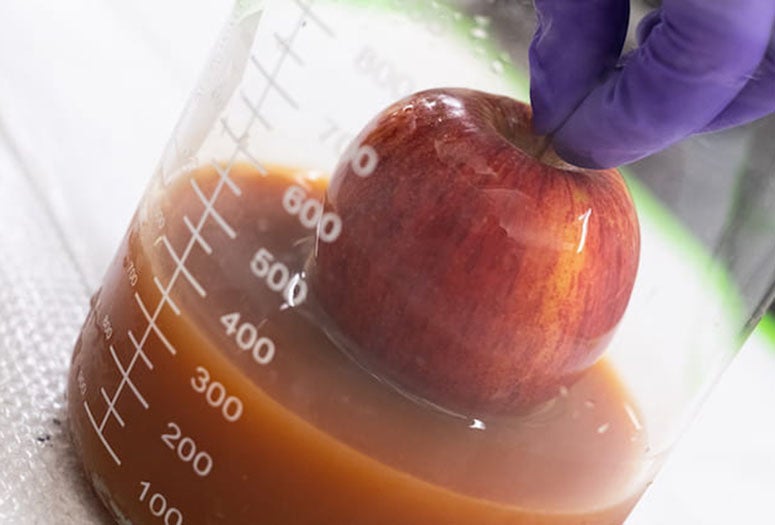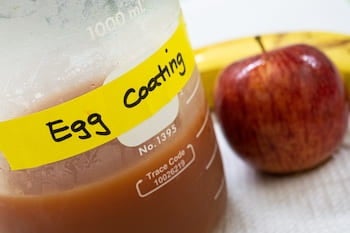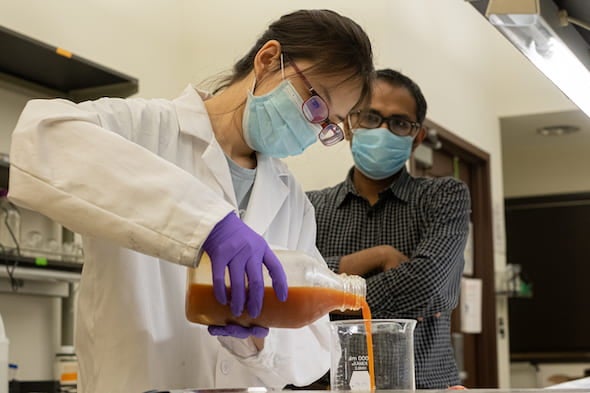HOUSTON – (June 4, 2020) – Eggs that would otherwise be wasted can be used as the base of an inexpensive coating to protect fruits and vegetables, according to Rice University researchers.
The Brown School of Engineering lab of materials scientist Pulickel Ajayan and colleagues have developed a micron-thick coating that solves problems both for the produce and its consumers, as well as for the environment.
When the coating was applied to produce by spraying or dipping, it showed a remarkable ability to resist rotting for an extended period comparable to standard coatings like wax but without some of the inherent problems.
The work by Rice undergraduate students Seohui (Sylvia) Jung and Yufei (Nancy) Cui is detailed in Advanced Materials.
The coating relies on eggs that never reach the market. As the United States produces more than 7 billion eggs a year and manufacturers reject 3% of them, the researchers estimate more than 200 million eggs end up in landfills.
Even before the impact of the new coronavirus, the world wasted a third of the food produced around the globe, the researchers wrote.
“Reducing food shortages in ways that don’t involve genetic modification, inedible coatings or chemical additives is important for sustainable living,” Ajayan said. “The work is a remarkable combination of interdisciplinary efforts involving materials engineers, chemists and biotechnologists from multiple universities across the U.S.”
Along with being edible, the multifunctional coating retards dehydration, provides antimicrobial protection and is largely impermeable both to water vapor to retard dehydration and to gas to prevent premature ripening. The coating is all-natural and washes off with water.
“If anyone is sensitive to the coating or has an egg allergy, they can easily eliminate it,” Jung said.
Egg whites (aka albumen) and yolks account for nearly 70 percent of the coating. Most of the rest consists of nanoscale cellulose extracted from wood, which serves as a barrier to water and keeps produce from shriveling, a small amount of curcumin for its antimicrobial powers and a splash of glycerol to add elasticity.
Lab tests on dip-coated strawberries, avocadoes, bananas and other fruit showed they maintained their freshness far longer than uncoated produce. Compression tests showed coated fruit were significantly stiffer and more firm than uncoated and demonstrated the coating’s ability to keep water in the produce, slowing the ripening process.
An analysis of freestanding films of the coating showed it to be extremely flexible and able to resist cracking, allowing better protection of the produce. Tests of the film’s tensile properties showed it to be just as tough as other products, including synthetic films used in produce packaging. Further tests proved the coating to be nontoxic, and solubility tests showed a thicker-than-usual film is washable. Rinsing in water for a couple of minutes can completely disintegrate it, Ajayan said.
The researchers continue to refine the coating’s composition and are considering other source materials. “We chose egg proteins because there are lots of eggs wasted, but it doesn’t mean we can’t use others,” said co-corresponding author Muhammad Rahman, a research scientist in Ajayan’s Rice lab, who mentored and led the team.
Jung noted the team is testing proteins that could be extracted from plants rather than animal produce to make coatings.
Co-authors of the paper are Rice graduate students Morgan Barnes, Aparna Adumbumkulath, Onur Sahin, Seyed Sajadi and Lucas Sassi; Rice research scientist Corwin Miller; Rice postdoctoral research associate Soumyabrata Roy; Matthew Bennett, an associate professor of biosciences at Rice; Rafael Verduzco, an associate professor of chemical and biomolecular engineering and of materials science and nanoengineering at Rice; Robert Vajtai, a research professor in materials science and nanoengineering at Rice; Reaz Chowdhury, a graduate research assistant, and Jeffrey Youngblood, a professor of materials engineering, at Purdue University; graduate student Jefferson Friguglietti and Fatima Merchant, an associate professor of computer engineering technology and computational health informatics, at the University of Houston; graduate research assistant Chinmay Satam, graduate student Yue Ji and J. Carson Meredith, a professor, James Harris Faculty Fellow and executive director of the Renewable Bioproducts Institute at the Georgia Institute of Technology; and postdoctoral researcher Shenxiang Zhang, Miao Yu, an associate professor of chemical and biological engineering, and Nikhil Koratkar, a professor of mechanical, aerospace and nuclear engineering, at Rensselaer Polytechnic Institute.
Ajayan is chair of Rice’s Department of Materials Science and NanoEngineering, the Benjamin M. and Mary Greenwood Anderson Professor in Engineering and a professor of chemistry.
The Robert A. Welch Foundation and the Brazilian Ministry of Education’s Coordination for the Improvement of Higher Education Personnel program supported the research.
-30-
Read the abstract at https://onlinelibrary.wiley.com/doi/abs/10.1002/adma.201908291.
Follow Rice News and Media Relations via Twitter @RiceUNews.
Video:
Video produced by Brandon Martin/Rice University
Related materials:
Ajayan Research Group: https://ajayan.rice.edu
Department of Materials Science and NanoEngineering: https://msne.rice.edu
George R. Brown School of Engineering: https://engineering.rice.edu
Images for download:
https://news-network.rice.edu/news/files/2020/06/0608_EGGS-1-web.jpg
Eggs that would otherwise be wasted can be used as the base of an inexpensive coating to protect fruits and vegetables, according to Rice University researchers. (Credit: Jeff Fitlow/Rice University)
https://news-network.rice.edu/news/files/2020/06/0608_EGGS-2-web.jpg
A coating developed at Rice University made primarily with protein from eggs that would otherwise be wasted can be used to extend the freshness of produce. (Credit: Jeff Fitlow/Rice University)
https://news-network.rice.edu/news/files/2020/06/0608_EGGS-3-web.jpg
Rice University undergraduate student Yufei (Nancy) Cui prepares a solution based on protein from wasted eggs. The solution can be used as a coating that extends the freshness of fruit and vegetables. With her is Rice research scientist and mentor Muhammad Rahman. (Credit: Jeff Fitlow/Rice University)
Located on a 300-acre forested campus in Houston, Rice University is consistently ranked among the nation’s top 20 universities by U.S. News & World Report. Rice has highly respected schools of Architecture, Business, Continuing Studies, Engineering, Humanities, Music, Natural Sciences and Social Sciences and is home to the Baker Institute for Public Policy. With 3,962 undergraduates and 3,027 graduate students, Rice’s undergraduate student-to-faculty ratio is just under 6-to-1. Its residential college system builds close-knit communities and lifelong friendships, just one reason why Rice is ranked No. 1 for lots of race/class interaction and No. 4 for quality of life by the Princeton Review. Rice is also rated as a best value among private universities by Kiplinger’s Personal Finance.



